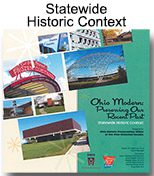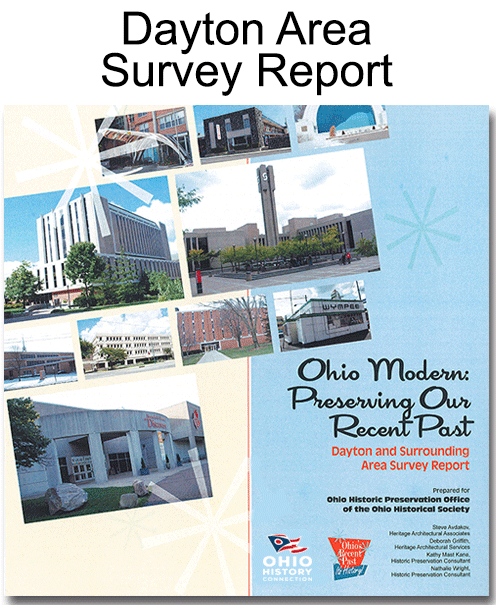From futuristic coffee shops, drive-ins and shopping centers to soaring glass curtain walled skyscrapers and the homes, schools, and churches of postwar suburbs, examples of mid-20th century architecture convey the hopes, challenges and successes of our recent history. These reminders of our recent past are as important to a community's sense of place and memory as early farmhouses and Italianate town squares. Now is the time to pay attention to what these modern buildings and sites tell us about our history and culture.
The State Historic Preservation Office (SHPO) launched the Ohio Modern initiative to identify significant social, political, and economic trends that shaped land-use decisions, architectural styles, property types and building technology in Ohio from 1940-1970 and record related properties. Ohio Modern products to date include a statewide historic context publication and history/architecture surveys in the Dayton area and Cleveland/Cuyahoga County that identify and evaluate mid-20th century properties and neighborhoods.


The Ohio Modern Statewide Historic Context document outlines the important social, political, and economic trends that shaped land-use decisions, architectural styles, property types, and building technology in Ohio associated with the recent past (1940-1970). The period begins with the years immediately leading up to World War II. The events of the war years set into motion massive socioeconomic transformations, trends and patterns of historical development that shaped Ohio for the next three decades. The period ended in 1970; the early 1970s marked a period of transition for Ohio that included de-industrialization, assumption of new responsibilities by state and local government, and demographic and socioeconomic trends as the state's metropolitan areas grew and the population transitioned from rural to suburban settings.
Research Design and Project Methods
Design Trends in Ohios, 1940-1970
Identification, Documentation, Evaluation, and Registration of Ohio's Recent Past Resources



The Cleveland and Cuyahoga County Survey Report documents mid-twentieth-century properties and neighborhoods in the City of Cleveland, select suburban communities, and major transportation corridors in Cuyahoga County.
The information generated from the survey has provided a more complete understanding and recognition of mid-century historic properties in Cuyahoga County. Such information is essential for future planning purposes, research projects, National Register of Historic Places nominations, and coordination of federal, state, and local projects.
Introduction to the Cleveland and Cuyahoga County Survey
Cuyahoga County Environmental Setting
Early History of Cleveland and Cuyahoga County
Religion/Ecclesiastical Groups
Survey Methods, Results, and Recommendations
Appendix A: Surveyed Resources by Ohio Historic Inventory Numbers (Not available)
Appendix B: Known Architects and Builders of Surveyed Resources


Section 1: Introduction
Introduction to the Ohio Modern-Dayton Survey
Historic Context
Section 2: Survey Methodology
Literature Review
Prior Survey Summary & Research Methods
Field Survey Techniques & Discussion of Added OHI Terminology
Section 3: Analysis and Recommendations
Summary/Explanation of OHI and Relationship to Historic Context
Education
Ethnic/Immigration
Manufacturing/Industrial
Military/Defense
Political/Social Welfare
Religion/Ecclesiastical Groups
Arts and Recreation
Transportation/Communication
Architectural Findings
Representative Architectural Elements
Section 4: Resources
Published Sources
Unpublished Sources
Historic Image Reference
Section 5: Appendices
Appendix A - Maps
Appendix B - Historic Images
Appendix C - Architects Practicing in the Dayton Area
Appendix D - Interview Summaries
Appendix E - Table of Ohio Historic Inventory Forms

The State Historic Preservation Office (SHPO) received a Preserve America grant from the National Park Service, Department of the Interior, to complete the statewide context and the Dayton Survey. Additional support and partners include the Ohio Department of Transportation, Ohio Department of Development, Ohio Humanities Council (a state affiliate of the National Endowment for the Humanities), the City of Dayton, the University of Dayton and the Historic Preservation Fund of the National Park Service.
The Cleveland/Cuyahoga County Survey Project was completed with support from Hurricane Sandy Relief Grant funds also awarded through the National Park Service.
The Ohio Historic Inventory (OHI) is the ongoing statewide survey of buildings, sites, structures and objects of historical and architectural significance. The OHI is used to record basic information about historic properties. Since 1974, more than 97,000 landmark properties have been recorded in this essential reference for organizing community preservation efforts.
The OHI form provides a brief description of the location, history and architecture of a building, site, structure, or object of architectural or historical significance. Approximately 200 OHI forms were completed at the intensive level of documentation, including a full architectural description and historical documentation for the property. Some 300 properties were recorded at a reconnaissance level of documentation, meaning that basic architectural information and limited historic research are recorded. Reconnaissance level forms may not have all fields completed. Many properties recorded at the reconnaissance level are examples of Cape Cod Cottages, Ranch Houses and Split-Levels that collectively represent repetitive house types defining several mid-20th century neighborhoods and subdivisions.
